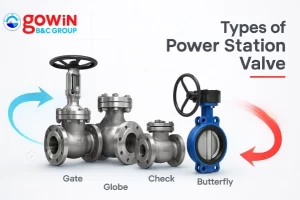Table of Contents
ToggleA bolted bonnet globe valve is one of the primary types of industrial valves characterized by a bonnet or the upper part of the valve attached to the body via bolts instead of the traditional way of screwing them on.
When shopping for a globe valve bolted bonnet-style, there are times when the provider elaborating what it is won’t be sufficient. So, in this regard, the Gowin team knows your needs and will offer you a complete guide to everything about these globe valves.
What Are Bolted Bonnet Globe Valves?
Your bolted bonnet globe valve manufacturer will also tell you that these globe valves are where the bonnet – that which houses the stem and disc – is attached to the body via bolts.
Because of this design, they are best for higher pressures due to the connection that provides a tighter sealing. Thus, they are sustainable for various industries, such as those that need accurate throttling and shutting off.
What Are Its Primary Design Features?
A globe valve bolted bonnet-type generally has the same design features, regardless of what bolted bonnet globe valve supplier where you outsource them. These are:
- Body: Aside from the design discussed earlier, these globe valves feature a body material typically made of strong steel or iron, which protects the valve from corrosion and damage.
- Flow path: Located within the globe valve, this is designed to create as little unfavorable impact as possible during the valve’s operations.
- Sealing mechanism: The last main part is the sealing mechanism, which is important to prevent leaks. Tight sealing is maintained even under fluctuating pressures.
How Do They Work?
Those design features work in synergy to help in the efficient running of your industry’s operations. The first part of the working principle of a bolted bonnet globe valve is upon its opening and closing mechanism.
As soon as the valve is enabled, the stem works to raise or lower the disc. Meanwhile, when completely closed, the disc sits against the valve’s internal surface, thus creating the sealing. Remember, when the valve is opened, the disc motions away from the seat, letting the fluid pass by.
Now, to regulate for better flow, the position of the disc is adjusted so the flow rate happens with extreme precision. This is what makes a bolt bonnet globe valve factory effective when managing fluid flow.
How to Maintain Bolted Bonnet Globe Valves
No matter how high-performing their features are or how you make yourself familiar with these valves’ working principles, without properly maintaining and caring for them like how you do with your car, you’ll yield to purchasing new ones every now and then, which is costly, of course. Follow these tips to help keep these valves in tip-top shape:
- Regularly inspect these valves to spot signs of damage or tearing. Signs include leaks around the bonnet. During regular inspections, ensure that the bolts are securely fastened and properly tightened.
- Like in various other aspects, lubrication works by preventing corrosion and ensuring things run smoothly. Always keep the valve clean, removing debris that can affect its performance.
- Buckle up here. Even if you are regularly inspecting and cleaning your bolted bonnet globe valve, there are instances when it is impossible to revive it when some components have worn out. Do not compromise your industrial operations, so replace those parts promptly to avoid leaks and other issues.
How to Install Them Properly
Whether you’ve replaced your valve or purchased it from your wholesale bolted bonnet globe valve provider, there are times you’ll need to oversee the installation process if you don’t have an expert by your side. Here are the installation steps:
1. Prepare the essential tools:
- Gasket material
- Measuring tape
- Screwdrivers
- Sockets
- Torque wrench and other wrenches
2. Take note of the materials required:
- Fittings for your pipe
- Gaskets
- Mounting brackets (if necessary)
- Your bolted bonnet globe valve itself
3. Conduct preparation steps by assessing the site where the valves will be installed, verifying whether the valve is compatible with the piping system you have, and inspecting your new valve for defects. If you don’t manage to tick the boxes here, you may need to re-purchase the valve.
4. The installation begins with the alignment of the valve with your existing piping.
5. Then, the gasket must be properly inserted to prevent leaks.
6. The valve must be secured with bolts. Tighten and use the appropriate tools, such as your wrench.
7. Check for leaks, and tighten if there are.
8. Test the valve. Open and close it in test phases to ensure it works smoothly without obstructions. You’re done. Your valve is ready for actual operations.

Conclusion
You can see it isn’t difficult to understand this special type of globe valve. Bolted bonnet globe valves are distinct from the rest because of their structure and design. They work best when fluids flow at a much faster rate in your workplace.
Also, remember that ensuring they function the way they are intended to depends on your habits of caring for them. Conduct regular cleaning to ensure they are in their best shape. The moment you spot just a single damage, replace them immediately. You can either coordinate with an installation expert or handle the installation on your own.
Gowin Valves is a renowned China globe valve bolted bonnet factory. Our company has been in the industry since 2007, so we know how to match your needs with our extensive catalog. Each of our products is presented on a crisp digital page detailing its features and technical specifications. To get to know more about our globe valves and beyond, you can speak with our representatives today.








